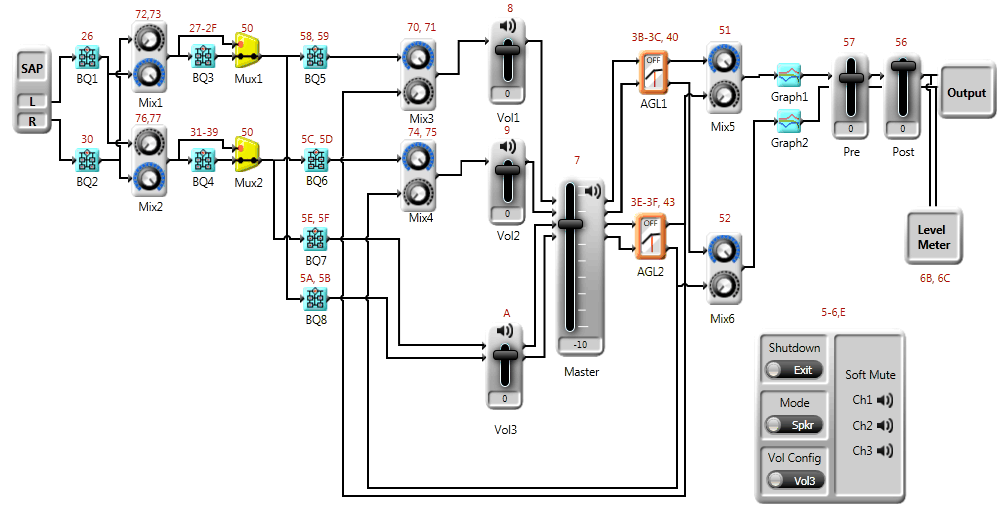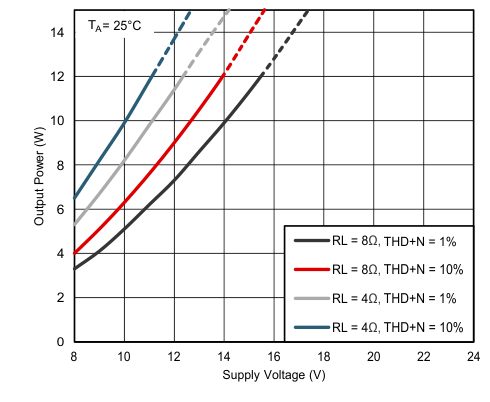ZHCSB75E May 2013 – June 2016 TAS5729MD
PRODUCTION DATA.
- 1 特性
- 2 应用
- 3 描述
- 4 修订历史记录
- 5 Related Devices
- 6 Pin Configuration and Functions
-
7 Specifications
- 7.1 Absolute Maximum Ratings
- 7.2 ESD Ratings
- 7.3 Recommended Operating Conditions
- 7.4 Thermal Information
- 7.5 Digital I/O Pins
- 7.6 Master Clock
- 7.7 Serial Audio Port
- 7.8 Protection Circuitry
- 7.9 Speaker Amplifier in All Modes
- 7.10 Speaker Amplifier in Stereo Bridge Tied Load (BTL) Mode
- 7.11 Speaker Amplifier in Stereo Post-Filter Parallel Bridge Tied Load (Post-Filter PBTL) Mode
- 7.12 Headphone Amplifier and Line Driver
- 7.13 Reset Timing
- 7.14 I2C Control Port
- 7.15 Typical Electrical Power Consumption
- 7.16 Typical Characteristics
- 8 Parameter Measurement Information
-
9 Detailed Description
- 9.1 Overview
- 9.2 Functional Block Diagram
- 9.3 Feature Description
- 9.4 Device Functional Modes
- 9.5 Programming
- 9.6
Register Maps
- 9.6.1 Clock Control Register (0x00)
- 9.6.2 Device ID Register (0x01)
- 9.6.3 Error Status Register (0x02)
- 9.6.4 System Control Register 1 (0x03)
- 9.6.5 Serial Data Interface Register (0x04)
- 9.6.6 System Control Register 2 (0x05)
- 9.6.7 Soft Mute Register (0x06)
- 9.6.8 Volume Registers (0x07, 0x08, 0x09)
- 9.6.9 Volume Configuration Register (0x0E)
- 9.6.10 Modulation Limit Register (0x10)
- 9.6.11 Interchannel Delay Registers (0x11, 0x12, 0x13, and 0x14)
- 9.6.12 PWM Shutdown Group Register (0x19)
- 9.6.13 Start/Stop Period Register (0x1A)
- 9.6.14 Oscillator Trim Register (0x1B)
- 9.6.15 BKND_ERR Register (0x1C)
- 9.6.16 Input Multiplexer Register (0x20)
- 9.6.17 Channel 4 Source Select Register (0x21)
- 9.6.18 PWM Output MUX Register (0x25)
- 9.6.19 AGL Control Register (0x46)
- 9.6.20 PWM Switching Rate Control Register (0x4F)
- 9.6.21 EQ Control (0x50)
-
10Application and Implementation
- 10.1 Application Information
- 10.2
Typical Applications
- 10.2.1 Stereo BTL Configuration With Headphone and Line Driver Amplifier
- 10.2.2 Mono PBTL Configuration with Headphone and Line Driver Amplifier
- 11Power Supply Recommendations
- 12Layout
- 13器件和文档支持
- 14机械、封装和可订购信息
1 特性
- 音频 I/O 配置
- 音频数字信号处理:
- 数字均衡
- 双频带自动增益限制
- 粗略和精密音量控制
- 脉宽调制 (PWM) 电平计量
- 常规运行 特性:
- 音频性能(PVDD = 18V,R负载 = 8Ω)
- 空闲声道噪声 = 56µVrms
- 1W,1kHz 时的总谐波失真 + 噪声 (THD+N) = 0.15%
- 信噪比 (SNR) = 105dB(以 0dBFS 为基准)
2 应用
- LCD/LED TV 和多用途监视器
- 条形音箱,扩展坞,PC 音频
- 消费类音频设备
3 描述
TAS5729MD 是一款立体声 I²S 输入器件,其配有数字音频处理器,可提供双频带自动增益限制 (AGL)、数字均衡、粗略和精细音量控制以及 PWM 电平计量等功能。AGL 是一种增强型动态范围压缩 (DRC) 功能。该器件可在宽泛的 PVDD 电源范围内工作,因此可适应各类 应用。TAS5729MD4.5运行电压范围为 V 至24VDC 的标称电源电压。该器件由 I²C 控制端口进行控制。该器件配有集成 DirectPath™ 耳机放大器和线路驱动器,可提高系统级集成度并削减解决方案总成本。
输出金属氧化物半导体场效应晶体管 (MOSFET) 的 200mΩ DS(ON) 兼顾散热性能与器件成本,二者相得益彰。此外,该器件采用耐热增强型 HTSSOP 封装,在现代消费类电子器件的较高工作环境温度下展现出优异的性能。
整个 TAS5729xx 系列均实现引脚兼容,允许在多个终端应用平台使用同一款硬件解决方案。此外,整个 TAS5729xx 系列的 I²C 寄存器映射相同,因此当需要根据系统级要求选择器件时,可以降低开发工作量。
器件信息(1)
| 器件型号 | 封装 | 封装尺寸(标称值) |
|---|---|---|
| TAS5729MD | HTSSOP (48) | 12.50mm x 6.10mm |
- 要了解所有可用封装,请参见数据表末尾的可订购米6体育平台手机版_好二三四附录。
信号处理流程

10% THD+N 时的功率与 PVDD 间的关系

NOTE:
虚线表示散热受限的区域。